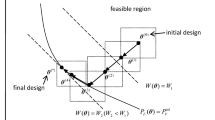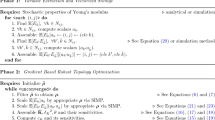Abstract
The paper discusses the general problem of structural loading. An attempt is made first to define a loading action; the concept of random loading is important in predicting the loads which will be experienced by a structure within an environment, interpreted in the broadest sense. Examples of stationary and nonstationary random-loading processes and rare, severe loading are discussed briefly. The effects of random loading on linear systems can be studied analytically; the interpretation of these effects is difficult in practice. It is concluded that a fuller knowledge of structural loading actions is required to rationalize structural-design procedures; there are serious economic barriers to acquiring more knowledge of structural environmental conditions, and considerable computational difficulties are likely to arise in analyzing practical problems of random loading.
Similar content being viewed by others
References
Jammer, M., “Concepts of Force”, Harvard Univ. Press (1957).
Bogdanoff, J. L., Goldberg, J. E., and Bernard, M. C., “Response of a Simple Structure to a Random Earthquake-type Disturbance”,Bltn. Seismological Soc. America,51 (2), (April,1961).
Fung, Y. C., “Analysis of Dynamic Stresses in Aircraft Structures During Landing as Non-stationary Processes”, Jnl. Appl. Mech.,22 (1955).
Yaglom, A. M., “Introduction to the Theory of Stationary Random Functions”,Prentice-Hall, New York (1962).
Houbolt, J. C., Walls, J. H., and Smiley, R. F., “On Spectral Analysis of Runway Roughness and Loads Developed During Taxiing”, Natl. Advisory Comm. for Aeronautics, Tech. Note 3484 (1955).
Taylor, J., “Manual on Aircraft Loads”, Pergamon Press, 1965.
Lumley, J. L., andPanofsky, H. A., “The Structure of Atmospheric Turbulence”,Interscience, New York (1964).
Gumbel, E. J., “Statistics of Extremes”, Columbia Univ. Press (1958).
Shellard, H. C., “The Estimation of Design Wind Speeds”, Intl. Conf. on Wind Effects on Buildings and Structures, Her Majesty’s Stationery Off., London (1964).
Yuille, I. M., “Longitudinal Strength of Ships”, Trans. Inst. Naval Architects (1962).
Davenport, A. G., “The Buffeting of Structures by Gusts”, Intl. Conf. on Wind Effects on Buildings and Structures, Her Majesty’s Stationery Off., London (1964).
Harris, R. I., “The Response of Structures to Gusts”, Ibid. Intl. Conf. on Wind Effects on Buildings and Structures, Her Majesty’s Stationery Off., London (1964).
Lebedev, V. L., “Random Processes in Electrical and Mechanical Systems”,State Publishing House of Physical and Math. Lit., Moscow (1958). (English translation published by Israel Program for Scientific Translations.)
Crandall, S. H., andMark, W. D., “Random Vibration in Mechanical Systems”,Academic Press, New York (1963).
Rice, S. O., “Mathematical Analysis of Random Noise”, Bell System Tech. Jnl.,23 and 24 (1944).
Author information
Authors and Affiliations
Rights and permissions
About this article
Cite this article
Chilver, A.H. Structural loading actions. Experimental Mechanics 6, 538–546 (1966). https://doi.org/10.1007/BF02327233
Issue Date:
DOI: https://doi.org/10.1007/BF02327233




